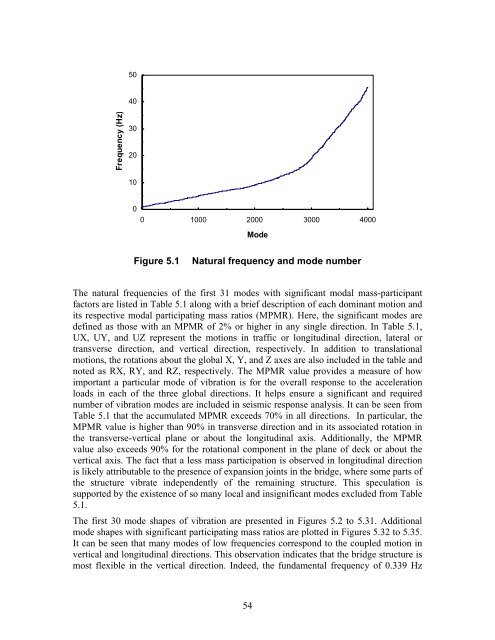Assessment of the Bill Emerson Memorial Bridge - FTP Directory ...
Assessment of the Bill Emerson Memorial Bridge - FTP Directory ...
Assessment of the Bill Emerson Memorial Bridge - FTP Directory ...
- No tags were found...
Create successful ePaper yourself
Turn your PDF publications into a flip-book with our unique Google optimized e-Paper software.
5040Frequency (Hz)30201000 1000 2000 3000 4000ModeFigure 5.1Natural frequency and mode numberThe natural frequencies <strong>of</strong> <strong>the</strong> first 31 modes with significant modal mass-participantfactors are listed in Table 5.1 along with a brief description <strong>of</strong> each dominant motion andits respective modal participating mass ratios (MPMR). Here, <strong>the</strong> significant modes aredefined as those with an MPMR <strong>of</strong> 2% or higher in any single direction. In Table 5.1,UX, UY, and UZ represent <strong>the</strong> motions in traffic or longitudinal direction, lateral ortransverse direction, and vertical direction, respectively. In addition to translationalmotions, <strong>the</strong> rotations about <strong>the</strong> global X, Y, and Z axes are also included in <strong>the</strong> table andnoted as RX, RY, and RZ, respectively. The MPMR value provides a measure <strong>of</strong> howimportant a particular mode <strong>of</strong> vibration is for <strong>the</strong> overall response to <strong>the</strong> accelerationloads in each <strong>of</strong> <strong>the</strong> three global directions. It helps ensure a significant and requirednumber <strong>of</strong> vibration modes are included in seismic response analysis. It can be seen fromTable 5.1 that <strong>the</strong> accumulated MPMR exceeds 70% in all directions. In particular, <strong>the</strong>MPMR value is higher than 90% in transverse direction and in its associated rotation in<strong>the</strong> transverse-vertical plane or about <strong>the</strong> longitudinal axis. Additionally, <strong>the</strong> MPMRvalue also exceeds 90% for <strong>the</strong> rotational component in <strong>the</strong> plane <strong>of</strong> deck or about <strong>the</strong>vertical axis. The fact that a less mass participation is observed in longitudinal directionis likely attributable to <strong>the</strong> presence <strong>of</strong> expansion joints in <strong>the</strong> bridge, where some parts <strong>of</strong><strong>the</strong> structure vibrate independently <strong>of</strong> <strong>the</strong> remaining structure. This speculation issupported by <strong>the</strong> existence <strong>of</strong> so many local and insignificant modes excluded from Table5.1.The first 30 mode shapes <strong>of</strong> vibration are presented in Figures 5.2 to 5.31. Additionalmode shapes with significant participating mass ratios are plotted in Figures 5.32 to 5.35.It can be seen that many modes <strong>of</strong> low frequencies correspond to <strong>the</strong> coupled motion invertical and longitudinal directions. This observation indicates that <strong>the</strong> bridge structure ismost flexible in <strong>the</strong> vertical direction. Indeed, <strong>the</strong> fundamental frequency <strong>of</strong> 0.339 Hz54
















